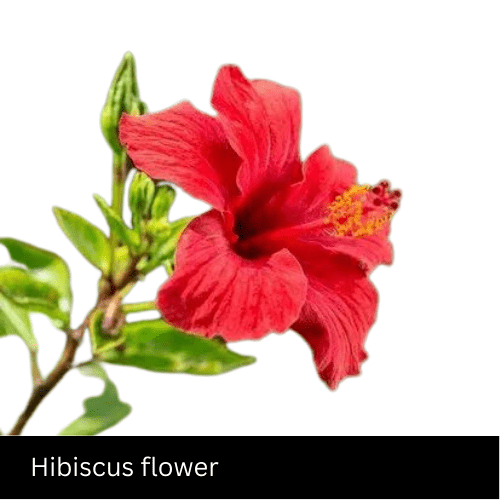The Hibiscus Flower is a large, showy flower with a wide range of colors, including red, pink, yellow, orange, and white. It has a trumpet-shaped structure with five petals and a distinctive central column of stamens. Flowers are often used in traditional medicine for their potential health benefits.
In addition to its ornamental and medicinal uses, the Hibiscus Flower is also used in the production of food and beverages. The flowers are dried and used to make hibiscus tea, a popular beverage in many parts of the world. The tea is known for its tart, fruity flavor and its potential health benefits, including lowering blood pressure and reducing cholesterol levels.
- Rose Mallow
- Chinese hibiscus
- Shoeblackplant
- Hawaiian Hibiscus
- Malaysia Bunga raya
- Indian Gurhal
- African rosemallow
- Common Hibiscus
- Queen of tropical flowers
- Jamaica sorrel
These names are used to refer to the same plant, Hibiscus Rosa-Sinensis, and are often used interchangeably in different regions.
10 Benefits of Hibiscus Flower / Hibiscus Rosa-Sinensis
-
May lower blood pressure: Hibiscus tea has been shown to have antihypertensive properties that may help to lower blood pressure levels.
-
May improve cholesterol levels: Some studies suggest that drinking hibiscus tea may help to reduce LDL (bad) cholesterol and triglycerides while increasing HDL (good) cholesterol levels.
-
May help with weight loss: Hibiscus tea is low in calories and may help to suppress appetite, making it a good addition to a weight loss diet.
-
May have anti-inflammatory effects: Hibiscus flower extracts have been shown to have anti-inflammatory properties that may help to reduce inflammation in the body.
-
May have antibacterial properties: Hibiscus flower extracts have been found to have antibacterial properties that may help to fight against certain types of bacteria.
-
May have anticancer properties: Some studies suggest that hibiscus flower extracts may have anticancer properties, although more research is needed in this area.
-
May help to manage diabetes: Hibiscus tea has been shown to have hypoglycemic effects that may help to lower blood sugar levels in people with diabetes.
-
May improve liver health: Some studies suggest that hibiscus flower extracts may have hepatoprotective properties that may help to protect the liver from damage.
-
May help to promote skin and hair health: Hibiscus flower extracts have been used in traditional medicine to help promote healthy skin and hair.
-
May have antioxidant properties: Hibiscus flower extracts are rich in antioxidants, which may help to protect the body from oxidative stress and damage caused by free radicals.
-
Single Hibiscus: This type of hibiscus has a single layer of petals and a prominent stamen in the center.
-
Double Hibiscus: This type of hibiscus has double layers of petals, which make it look more full and lush.
-
Miniature Hibiscus: This type of hibiscus is smaller in size and produces smaller flowers.
-
Giant Hibiscus: This type of hibiscus produces larger flowers than the average hibiscus, with some varieties having flowers up to 12 inches in diameter.
-
Variegated Hibiscus: This type of hibiscus has flowers with unique patterns and variations in color, such as stripes or speckles.
-
Hybrid Hibiscus: This type of hibiscus is a result of crossbreeding different varieties of hibiscus to produce new and unique colors, shapes, and sizes.
These are just a few examples of the many types of Hibiscus Rosa-Sinensis that exist. Each variety has its own unique features and characteristics that make it popular among gardeners and flower enthusiasts.
- Hibiscus Flower
- Chinese hibiscus
- Rose Mallow
- Shoeblackplant
- Hawaiian Hibiscus
- Malaysia Bunga raya
- Indian Gurhal
- African rosemallow
- Common Hibiscus
- Queen of tropical flowers
- Jamaica sorrel
These are some of the most common names for Hibiscus Rosa-Sinensis, which is a popular flowering plant that is grown for its ornamental value, as well as its potential health benefits.
Flavour Of Hibiscus Flower / Hibiscus Rosa-SinensisHibiscus Rosa-Sinensis is known for its tart and tangy flavor, which is often described as being similar to cranberry or pomegranate. The flowers of the plant are commonly used to make a tea or infusion, which can be consumed either hot or cold. In addition to its tart flavor, hibiscus tea is also known for its vibrant red color, which is a result of the presence of pigments known as anthocyanins. The flavor of hibiscus tea can be enhanced by adding sweeteners such as honey or sugar, or by combining it with other ingredients such as ginger or lemon.
-
Anthocyanins: These are pigments that give the flowers their deep red color and are also powerful antioxidants that may have anti-inflammatory, antimicrobial, and anticancer properties.
-
Organic acids: Hibiscus flowers contain several organic acids, including citric acid, tartaric acid, and malic acid, which give the flowers their tart taste and may contribute to their potential health benefits.
-
Flavonoids: These are compounds found in many plants that have antioxidant and anti-inflammatory properties, and may also help to improve cardiovascular health.
-
Vitamin C: Hibiscus flowers are a good source of vitamin C, an essential nutrient that is important for immune function, skin health, and wound healing.
-
Polysaccharides: These are complex carbohydrates found in hibiscus flowers that may have immune-boosting and anti-inflammatory properties.
-
Tannins: These are bitter-tasting compounds that are found in many plants and may have antioxidant and anti-inflammatory properties, as well as potential benefits for digestive health.
These are just a few examples of the many chemicals found in Hibiscus Flower / Hibiscus Rosa-Sinensis, which may contribute to its potential health benefits and other properties.

